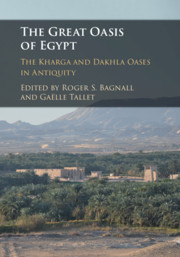Book contents
- The Great Oasis of Egypt
- The Great Oasis of Egypt
- Copyright page
- Contents
- Figures
- Tables
- Contributors
- Preface
- 1 Introduction
- Part I Living in the Oasis: Humans and the Environment
- 2 Water Resources and Irrigation in Two Oases of the Western Desert of Egypt: Kharga and Dakhla
- 3 The Ancient Population of the Kharga Oasis
- 4 Trimithis: A Case Study of Proto-Byzantine Urbanism
- Part II Managing the Oasis
- Part III Trade and Mobility in a Connected Environment
- Part IV An Oasis Culture?
- Bibliography
- Index of ancient people
- Index of places
- General index
3 - The Ancient Population of the Kharga Oasis
from Part I - Living in the Oasis: Humans and the Environment
Published online by Cambridge University Press: 12 July 2019
- The Great Oasis of Egypt
- The Great Oasis of Egypt
- Copyright page
- Contents
- Figures
- Tables
- Contributors
- Preface
- 1 Introduction
- Part I Living in the Oasis: Humans and the Environment
- 2 Water Resources and Irrigation in Two Oases of the Western Desert of Egypt: Kharga and Dakhla
- 3 The Ancient Population of the Kharga Oasis
- 4 Trimithis: A Case Study of Proto-Byzantine Urbanism
- Part II Managing the Oasis
- Part III Trade and Mobility in a Connected Environment
- Part IV An Oasis Culture?
- Bibliography
- Index of ancient people
- Index of places
- General index
Summary
Three sites of Kharga Oasis (Dush, Labakha, and El-Deir), which were explored between 1981 and 2010, are considered in this chapter. They were occupied from the end of the fourth century BC till the early fifth century AD. About a thousand buried individuals were examined. The studies concerned sex ratio, age at death, causes of death, and pathology of mummies. More men than women were discovered, and the number of children found was particularly high in the Christian cemetery at El-Deir. Regarding age at death, the main feature is the proportion of women between 12 and 40 (as at many cemeteries). The pathological study, mainly based on X-rays, revealed problems with bones (fractures, arthritis, scoliosis…), problems with teeth (worn teeth, decay cases), and many cases of bilharzia. Presence of GAL (growth arrest lines) was observed on many mummies or skeletons,indicating periods when food was inadequate. Exploring cemeteries revealed the activities of their inhabitants: they were mainly farmers and craftsmen involved in potting, weaving, wickerwork, stone-cutting, and woodwork. There were obviously “rich” and “poor” tombs, but differences in quality could be due to an impoverishment of populations between Ptolemaic and Roman times.
- Type
- Chapter
- Information
- The Great Oasis of EgyptThe Kharga and Dakhla Oases in Antiquity, pp. 30 - 45Publisher: Cambridge University PressPrint publication year: 2019

